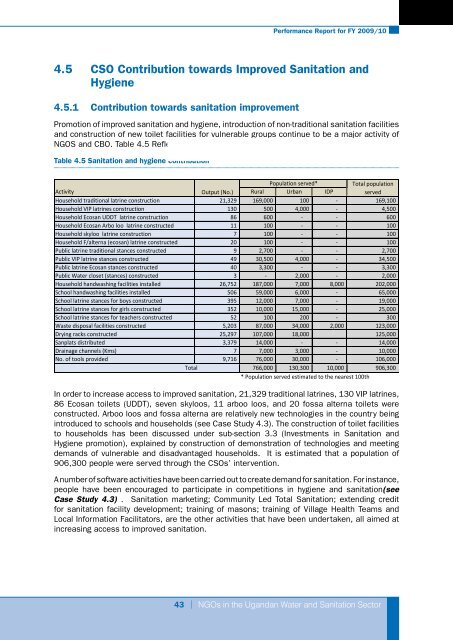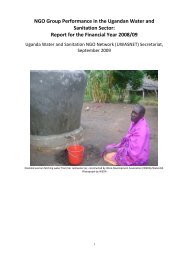Performance Report for FY 2009/10 - UWASNET
Performance Report for FY 2009/10 - UWASNET
Performance Report for FY 2009/10 - UWASNET
Create successful ePaper yourself
Turn your PDF publications into a flip-book with our unique Google optimized e-Paper software.
<strong>Per<strong>for</strong>mance</strong> <strong>Report</strong> <strong>for</strong> <strong>FY</strong> <strong>2009</strong>/<strong>10</strong><br />
4.5 CSO Contribution towards Improved Sanitation and<br />
Hygiene<br />
4.5.1 Contribution towards sanitation improvement<br />
Promotion of improved sanitation and hygiene, introduction of non-traditional sanitation facilities<br />
and construction of new toilet facilities <strong>for</strong> vulnerable groups continue to be a major activity of<br />
NGOS and CBO. Table 4.5 Reflects CSOs outputs towards improved sanitation and hygiene.<br />
Table 4.5 Sanitation and hygiene contribution<br />
Population served*<br />
Total population<br />
Activity Output (No.) Rural Urban IDP<br />
served<br />
Household traditional latrine construction<br />
21,329 169,000 <strong>10</strong>0 -<br />
169,<strong>10</strong>0<br />
Household VIP latrines construction<br />
130 500 4,000 -<br />
4,500<br />
Household Ecosan UDDT latrine construction<br />
86 600<br />
-<br />
-<br />
600<br />
Household Ecosan Arbo loo latrine constructed<br />
11 <strong>10</strong>0<br />
-<br />
-<br />
<strong>10</strong>0<br />
Household skyloo latrine construction<br />
7 <strong>10</strong>0<br />
-<br />
-<br />
<strong>10</strong>0<br />
Household F/alterna (ecosan) latrine constructed<br />
20 <strong>10</strong>0<br />
-<br />
-<br />
<strong>10</strong>0<br />
Public latrine traditional stances constructed<br />
9 2,700<br />
-<br />
-<br />
2,700<br />
Public VIP latrine stances constructed<br />
49 30,500 4,000 -<br />
34,500<br />
Public latrine Ecosan stances constructed<br />
40 3,300<br />
-<br />
-<br />
3,300<br />
Public Water closet (stances) constructed<br />
3<br />
-<br />
2,000 -<br />
2,000<br />
Household handwashing facilities installed<br />
26,752 187,000 7,000 8,000<br />
202,000<br />
School handwashing facilities installed<br />
506 59,000 6,000 -<br />
65,000<br />
School latrine stances <strong>for</strong> boys constructed<br />
395 12,000 7,000 -<br />
19,000<br />
School latrine stances <strong>for</strong> girls constructed<br />
352 <strong>10</strong>,000 15,000 -<br />
25,000<br />
School latrine stances <strong>for</strong> teachers constructed<br />
52 <strong>10</strong>0 200 -<br />
300<br />
Waste disposal facilities constructed<br />
5,203 87,000 34,000 2,000<br />
123,000<br />
Drying racks constructed<br />
25,297 <strong>10</strong>7,000 18,000<br />
125,000<br />
Sanplats distributed<br />
3,379 14,000<br />
-<br />
-<br />
14,000<br />
Drainage channels (Kms)<br />
7 7,000 3,000 -<br />
<strong>10</strong>,000<br />
No. of tools provided<br />
9,716 76,000 30,000 -<br />
<strong>10</strong>6,000<br />
Total<br />
766,000 130,300 <strong>10</strong>,000<br />
906,300<br />
* Population served estimated to the nearest <strong>10</strong>0th<br />
In order to increase access to improved sanitation, 21,329 traditional latrines, 130 VIP latrines,<br />
86 Ecosan toilets (UDDT), seven skyloos, 11 arboo loos, and 20 fossa alterna toilets were<br />
constructed. Arboo loos and fossa alterna are relatively new technologies in the country being<br />
introduced to schools and households (see Case Study 4.3). The construction of toilet facilities<br />
to households has been discussed under sub-section 3.3 (Investments in Sanitation and<br />
Hygiene promotion), explained by construction of demonstration of technologies and meeting<br />
demands of vulnerable and disadvantaged households. It is estimated that a population of<br />
906,300 people were served through the CSOs’ intervention.<br />
A number of software activities have been carried out to create demand <strong>for</strong> sanitation. For instance,<br />
people have been encouraged to participate in competitions in hygiene and sanitation(see<br />
Case Study 4.3) . Sanitation marketing; Community Led Total Sanitation; extending credit<br />
<strong>for</strong> sanitation facility development; training of masons; training of Village Health Teams and<br />
Local In<strong>for</strong>mation Facilitators, are the other activities that have been undertaken, all aimed at<br />
increasing access to improved sanitation.<br />
43 | NGOs in the Ugandan Water and Sanitation Sector



